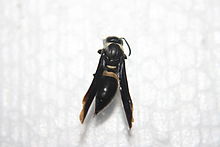- Monobia quadridens
-
Monobia quadridens Scientific classification Kingdom: Animalia Phylum: Arthropoda Class: Insecta Order: Hymenoptera Family: Vespidae Genus: Monobia Species: M. quadridens Binomial name Monobia quadridens
(Linnaeus, 1763)Synonyms [1] - Vespa quadridens Linnaeus, 1763
- Vespa cincta-nigra De Geer, 1773
- Vespa uncinata Fabricius, 1775
- Odycnerus uncinatus (Fabricius, 1775)
Monobia quadridens is a species of solitary potter wasp found in North America. It grows to a wingspan of 18 millimetres (0.71 in), and feeds on small caterpillars and pollen. There are two generations per year, with one generation overwintering as pupae.
Contents
Description
The abdomen of M. quadridens is entirely black, except for a broad ivory-coloured band on the first tergite.[2] The wingspan is typically 11–14.5 millimetres (0.43–0.57 in) for males, and 14–18 mm (0.55–0.71 in) for females.[2] It closely resembles Euodynerus bidens in size and colouration.[2]
Distribution
Monobia quadridens has a wide distribution in eastern North America. In Mexico, it is found in the states of Tamaulipas and Nuevo León, while in the United States, it is found from New Mexico, Kansas and Wisconsin east to the Eastern Seaboard.[2] The occurrence of the species in Canada has not been explicitly recorded in print, but specimens identified as M. quadridens have been present in Canadian entomological collections for a long time.[2]
Life cycle and ecology
Monobia quadridens is bivoltine, having two generations in a year. One emerges in summer, while the other overwinters as a pupa before emerging the following spring.[3] Copulation lasts for 30 minutes in M. quadridens, while in most wasp species, it only lasts a minute or two.[4] It nests in a variety of cavities including tunnels abandoned by carpenter bees, old mud dauber nests and hollow plant stems.[2]
The diet of M. quadridens is primarily composed of caterpillars of microlepidoptera, including species from the families Pyralidae, Crambidae, Elachistidae, Amphisbatidae, Gelechiidae and Tortricidae.[2] The diet also includes a large proportion of pollen.[5]
Sting
Like many wasps, Monobia quadridens is capable of delivering a sting. The pain caused by the sting of a female is similar to that caused by the bald-faced hornet or the ant Myrmecia nigripes.[6] Unlike most other wasps, however, the male is also capable of delivering a painful sting like a needle prick, although no venom is injected, so the pain is transient. The male has no stinger and uses the tip of its abdomen.[7]
Taxonomy
Monobia quadridens was first described by Carl Linnaeus in his 1763 work Centuria Insectorum, under the name Vespa quadridens.[8]
References
- ^ Frederick Smith (1857). "Monobia". Catalogue of Hymenopterous Insects in the Collection of the British Museum. Part V. Vespidae. British Museum (Natural History). pp. 41–42. http://books.google.co.uk/books?id=9nouAAAAYAAJ.
- ^ a b c d e f g Matthias Buck, Stephen A. Marshall & David K. B. Cheung (February 19, 2008). "Identification Atlas of the Vespidae (Hymenoptera, Aculeata) of the northeastern Nearctic region" (PDF). Canadian Journal of Arthropod Identification. doi:10.3752/cjai.2008.05. http://www.biology.ualberta.ca/bsc/ejournal/bmc_05/pdf/bmc05.pdf.
- ^ James H. Hunt (2007). "Life cycles in solitary wasps". The evolution of social wasps. Oxford University Press US. pp. 142–162. ISBN 9780195307856. http://books.google.co.uk/books?id=QkRCD1mVOasC.
- ^ Kenneth G. Ross & Robert W. Matthews (1991). "Courtship and copulation". The Social biology of wasps. Cornell University Press. pp. 64–66. ISBN 9780801499067. http://books.google.co.uk/books?id=QeGVqmfs_nIC.
- ^ James H. Hunt, Peggy A. Brown, Karen M. Sago & Jennifer A. Kerker (1991). "Vespid wasps eat pollen (Hymenoptera: Vespidae)" (PDF). Journal of the Kansas Entomological Society 64 (2): 127–130. http://www.umsl.edu/~huntj/Number%2046.pdf.
- ^ David L. Evans & Justin O. Schmidt (1990). "The physiological and pharmacological basis of venom effectiveness". Insect defenses: adaptive mechanisms and strategies of prey and predators. SUNY series in animal behavior. State University of New York Press. pp. 390–406. ISBN 9780887068966. http://books.google.co.uk/books?id=jpxkhS7O0p0C.
- ^ Phil Rau (1934). "The sting of the male wasp, Monobia quadridens" (PDF). Psyche 41 (4): 245–248. doi:10.1155/1934/96736. http://psyche.entclub.org/pdf/41/41-245.pdf.
- ^ J. van der Vecht & James M. Carpenter (1990). "A catalogue of the genera of the Vespidae (Hymenoptera)" (PDF). Zoologische Verhandelingen 260: 1–62. http://www.repository.naturalis.nl/document/148842.
Categories:- Potter wasps
- Hymenoptera of North America
- Animals described in 1763
Wikimedia Foundation. 2010.

